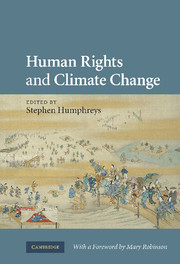Book contents
- Frontmatter
- Contents
- Authors' biographies
- Acronyms
- Acknowledgements
- Foreword
- Introduction: human rights and climate change
- PART I Rights perspectives on global warming
- PART II Priorities, risks and inequities in global responses
- 6 The Kyoto Protocol and vulnerability: human rights and equity dimensions
- 7 Forests, climate change and human rights: managing risks and trade-offs
- 8 Climate change and the right to the highest attainable standard of health
- 9 Human rights and vulnerability to climate change
- 10 Climate change, evolution of disasters and inequality
- Conclusion
- Appendix: climate change impacts on human rights
- Index
8 - Climate change and the right to the highest attainable standard of health
from PART II - Priorities, risks and inequities in global responses
Published online by Cambridge University Press: 04 August 2010
- Frontmatter
- Contents
- Authors' biographies
- Acronyms
- Acknowledgements
- Foreword
- Introduction: human rights and climate change
- PART I Rights perspectives on global warming
- PART II Priorities, risks and inequities in global responses
- 6 The Kyoto Protocol and vulnerability: human rights and equity dimensions
- 7 Forests, climate change and human rights: managing risks and trade-offs
- 8 Climate change and the right to the highest attainable standard of health
- 9 Human rights and vulnerability to climate change
- 10 Climate change, evolution of disasters and inequality
- Conclusion
- Appendix: climate change impacts on human rights
- Index
Summary
The health of individuals, communities and populations requires more than medical care. Equally important are the environmental, social, cultural, economic, political and other conditions that make people need medical care in the first place.
For this reason, the right to the highest attainable standard of health is an inclusive right extending not only to timely and appropriate medical care but also to the underlying determinants of health, such as access to safe water and adequate sanitation, an adequate supply of safe food, nutrition and housing, healthy occupational and environmental conditions, access to health-related education and information, including on sexual and reproductive health and freedom from discrimination. In short, the right to the highest attainable standard of health encompasses both medicine and public health. The International Covenant on Economic, Social and Cultural Rights (ICESCR) and the Convention on the Rights of the Child (CRC), for example, are clear that the right to health extends beyond medical care.
Given the massive public health challenge posed by climate change, especially in the developing world, there is an urgent need for a global partnership aimed at establishing an effective, integrated environmental regime capable of ensuring healthy environmental conditions for all. Here we signal some dimensions of the contribution that the right to the highest attainable standard of health can make as the international community seeks to respond to this challenge. Climate change represents an extremely grave risk to the health of individuals, communities and populations, especially those living in poverty in developing countries.
- Type
- Chapter
- Information
- Human Rights and Climate Change , pp. 238 - 256Publisher: Cambridge University PressPrint publication year: 2009
- 1
- Cited by

